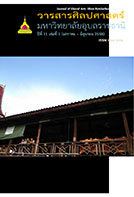การพัฒนาบุคลากร กรณีศึกษา มหาวิทยาลัยอุบลราชธานี
Main Article Content
บทคัดย่อ
ผลการวิจัยพบว่า สภาพการพัฒนาบุคลากรภาพรวมอยู่ในระดับ ปานกลาง ความต้องการการพัฒนาบุคลากรภาพรวมอยู่ในระดับมาก โดย ต้องการให้มหาวิทยาลัยพัฒนาด้านทัศนคติมากที่สุด บุคลากรที่มีเพศ และอายุ ต่างกัน มีความต้องการพัฒนาบุคลากรไม่แตกต่างกัน ส่วนบุคลากรที่มีระดับ การศึกษาแตกต่างกัน จะมีความต้องการพัฒนาบุคลากรแตกต่างกัน
ความสัมพันธ์ระหว่างสภาพการพัฒนาบุคลากรในปัจจุบันกับแนว ทางการพัฒนาบุคลากร มีความสัมพันธ์กัน ในระดับต่ำและในทิศทางเดียวกัน (r = 0.098) อย่างมีนัยสำคัญทางสถิติที่ระดับ .05 และความสัมพันธ์ระหว่าง ความต้องการพัฒนาบุคลากร กับแนวทางการพัฒนาบุคลากร มีความสัมพันธ์กัน ในระดับปานกลางและในทิศทางเดียวกัน (r = 0.548) อย่างมีนัยสำคัญทางสถิติที่ ระดับ .05
Personnel Development: A Case Study of Ubon Ratchathani University
The purpose of this research is to study the current condition of Ubon Ratchathani University (UBU) personnel development and its personnel development needs analysis. This research also studies the relationship between current personnel development and personnel development approach, and the relationship between personnel development needs analysis and personnel development approach. Using quantitative methods, questionnaires were used to collect data from 418 UBU staff. The data was then analyzed by using frequency count, percentage, mean, standard deviation, T-Test, F-Test, Least Significant Difference (LSD) and Pearson’s Correlation.
The results of the research reveal that the overall current condition of personnel development is at an average level and the overall personnel development needs are at a high level, particularly in attitude development. Gender and age do not affect personnel development needs. However, different educational backgrounds result in different personnel development needs.
A Pearson product-moment correlation coefficient was computed to assess the relationship between current personnel development and personnel development approach. There was a weak correlation between the two variables (r = 0.098), with statistical significance level of .05. There was a moderate correlation between personnel development needs and personnel development approach (r = 0.548) with statistical significance level of .05.


